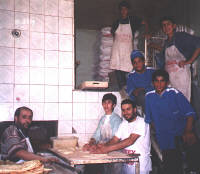 |
| Some of the friendly people who helped Kartini and her friend eat meatless. |
Kebabistan
So, the minute I landed in Istanbul and got me a bed in the hostel, I went on a quest for the famous kebab. Turning my nose up at the touristy restaurants in Sultanahmet, I dodged into a small lane and walked up narrow streets and alleys, in search of a place that looked like a locals’ lunch haunt. Fifteen minutes and 18 streets later, with absolutely no idea where I was, I nervously peeked into an empty restaurant which nonetheless looked open.
Gingerly I stepped in, and was greeted by a smiling old man in a white apron, two sharp knives in his hand. He gestured for me to sit down, anywhere, and as I dropped into a seat by the wall, I was so happy to see a menu on the table. Sure, it was all in Turkish, but at least I understood one word: “kebab”. There must have been 10 different kinds of kebabs listed, and not knowing the difference between them, I ordered the Iskender Kebab.
It was yummy and very filling. A plate of thinly-sliced meat pieces in what tasted like a tomato-based sauce served with a lot of yogurt on the side. The waiter plonked down a huge plastic container full of bread, thus introducing me to what turned out to be one of my favourite aspects of Turkish cuisine: the “bottomless basket” of bread served at meals.
As I got busy fattening myself up on wholesome European bread (all I get back home is sliced bread), I soon discovered a layer of bread bits soaked in the kebab sauce, infused with meat juices, hiding just beneath the layer of meat. Needless to say, I emerged from that meal a very happy person, with my bread-lust fully sated.
The majority of my meals in Turkey consisted of the ubiquitous Doner Kebabs one sees being sold on many street corners. I found the Doners a delicious, nutritious and cheap way of satisfying my frequent hunger pangs. The meat or chicken is sliced off a large skewered chunk, then placed in a half-loaf of bread already stuffed with tomatoes and lettuce. Add potatoes and a generous sprinkling of chili (a.k.a. biber), down it with some ayran (yogurt drink), and you get the best deal on a meal in Turkey � absolutely yummy and all for under US$1.
Desperately Seeking Sebze (vegetables)
“Enough already about the meats!” you may be saying to yourself. “I wanna hear about the vegetarian yemek (food) in Turkey’s largely meat-eating culture.”
Well, I have seen quite a few restaurants in Istanbul catering to the vegetarian tourist, with dishes such as Eggplant Kebab or Vegetarian Pide (pizza). The problem, I would say, presents itself when you go off the beaten tourist track and can barely speak the language.
My Epicurean adventure with vegetarian Turkish fare began in Van. Van is in Eastern Anatolia, a city with many hotels but not many tourists at all, or so it seemed. Lake Van is a natural tourist attraction, but due to difficulties with the Kurdish situation, tourism has declined sharply in recent years.
Thus, when I saw another yabanci (foreigner) sitting on a rock, staring out wistfully towards the huge, shimmering lake, I walked right up to him and introduced myself. On hindsight, he was probably dreaming about his next delicious Turkish meal when I rudely interrupted. Trevor was an Australian who had just come overland from Iran. When I met him, he was totally enamored with Turkish food, which he found so tasty, after Iran.
I was surprised to learn that he was vegetarian, yet enjoyed Turkish food so much. I had always thought that it must be interesting, to say the least, to be vegetarian in Turkey. I had enjoyed some wonderful vegetarian meals at the hostel dinners in Olimpos, but otherwise the concept seemed as foreign to Turkish cuisine as pork. Turkey has the freshest and juiciest tomatoes and cucumbers I have ever tasted, and they can do amazing things with an eggplant, but beyond that I could not imagine what vegetarian Turkish fare would consist of. I was itching to find out.
Trevor too was a big fan of the “bottomless basket” of bread, so we looked for a lokantasi. These are often no-frills, cheap restaurants where you can simply point to the dishes that you want, plus you get the “bottomless basket” of bread with your meal. These establishments usually have about 8 to 12 different dishes on offer, often a mix of meat and vegetable dishes that are displayed in a glass case near the entrance.
The lokantasi we settled on only had lentil soup and chickpeas in gravy, in addition to a myriad of meat dishes. As we stepped in, the waiter addressed us in English, “Welcome, welcome, many tourists come here.” NOT what we wanted to hear. Neither were the prices. But we were hungry, so we slurped down the lentil soup and resolved to continue our quest for food. We would find a cheaper place next time, one filled with locals, we told ourselves.
Read Part 2 of Vegetarian Yemek in Kebabistan and Part 3 of Vegetarian Yemek in Kebabistan.